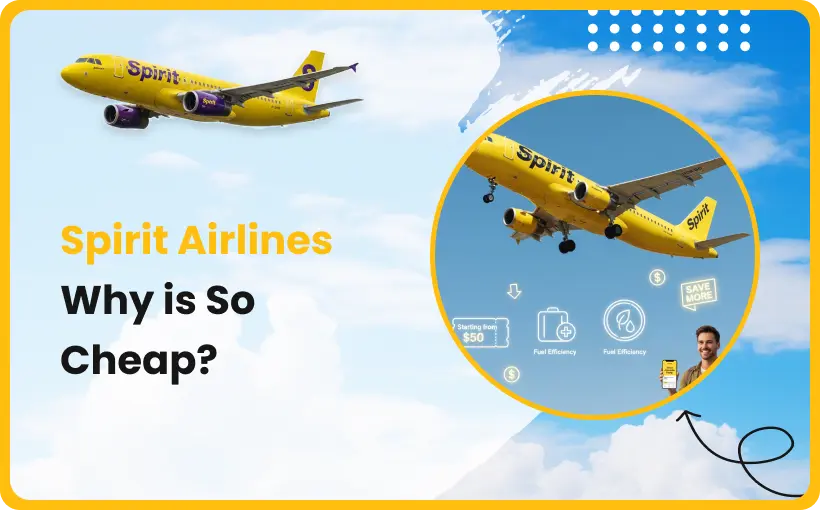
Why is Spirit Airlines So Cheap? Unpacking Their Ultra-Low-Cost Model
Spirit airlines is known as the cheapest airline. Their prices are significantly lower compared to other airlines. Their facilities may be less than those of other airlines, but most of the facilities that Spirit offers are equal, so you may think, Why is Spirit Airlines so cheap? and How did they cut their cost? Well, they have achieved this with their unique business model. In this blog, we will discuss this topic in detail and try to reach a conclusion about why this airline is so affordable and what impact it has on its passengers.
The "À La Carte" Approach: Paying Only for What You Need
Spirit Airlines is known for its affordability, excellent services, and facilities. But do you know how they cut their costs to offer these low-price flights?, What business model do they follow? Spirit airlines follows the "à la carte" business model approach to cut its costs.
A la carte model means a very basic approach to air travel. Spirit does not include amenities such as baggage allowance, beverages, snacks, and in-flight Wi-Fi in their ticket, which means they have to pay for every extra allowance. And this is the main income of Spirit Airlines. It also allows the passengers to pay only for the necessities they need and save on the facilities that are not required for them.
Spirit Airlines works on this model for passengers who want to fly for the least amount possible and don’t require many facilities. To maintain this ULCC label, various models and approaches are employed, and these are continually refined and updated.
Where Spirit Cuts Costs: A Look at Their Operational Efficiency
The question is not only why Spirit flights are so cheap, but also how they manage their expenses. Well, they have included these points in their business model to cut their cost and save passengers money:
Fewer In-Flight Facilities
Spirit focuses on necessities, not luxuries. This means:
- Minimal amenities: No complimentary in-flight entertainment, extra baggage allowance (without a fee), or other non-essential comforts are provided.
- Streamlined seating: Their aircraft feature thinner seats with less padding and minimal legroom, allowing them to fit more passengers on each flight, which increases revenue per flight.
Optimized Operating Costs
Spirit strategically reduces its operational footprint:
- Quick turnarounds: They keep the time aircraft spend on the ground between flights (turnaround time) very short. This maximizes aircraft utilization and allows them to operate more flights daily.
- Secondary airports: Spirit often utilizes smaller, less congested, and more cost-effective secondary airports instead of major hubs. These airports typically have lower landing fees and operational costs.
The "No-Frills" Fleet
Spirit adheres to a "no-frills" approach regarding its aircraft fleet:
- Single-family fleet: They primarily operate aircraft from a single family – the Airbus A320 series (A319, A320, and A321). This standardization simplifies crew training, reduces maintenance complexity, and lowers the cost of spare parts inventory.
Point-to-Point Travel
Instead of the traditional hub-and-spoke model, Spirit uses a point-to-point model:
- Direct routes: Flights connect directly between cities without requiring passengers to make connecting stops at large, expensive hub airports. This eliminates the operational costs associated with maintaining hub facilities and managing complex connecting itineraries.
Other Contributing Factors
There are many other factors that help them in earning more, even while providing fewer facilities.
- New consumer appeal: The airline appeals to new consumers, who cover the customers who are not the flight consumers from before.
- Higher passenger density: The flight model used by Spirit carries more passengers than other airlines, which also increases their revenue
- Fuel efficiency and less competitive routes: Their flight is fuel-efficient, and they follow less competitive routes.
- Increased flight frequency: Their quick turnarounds increase the flight frequency.
The Marketing Impact: Affordability as a Core Value
As per the studies, 70% of passengers who travel with Spirit do so because of its low-cost model. Spirit mainly covers passengers who need affordability over facilities. Spirit airlines has designed its business model in this way to reach more and more people. Their main and significant revenue comes from the ancillary services. According to the 2020 report of the International Air Transport Association, the 40% revenue of Spirit Airlines came from ancillary services, which benefits the airlines and also the consumers, as they are only paying for the required necessities.
Ancillary services such as wifi, snacks and beverages, extra baggage, seat selections, pet carrier allowance, etc.
Conclusion
After reading all the points, you must have known that Spirit Airlines works very wisely to save costs. They introduced this model in 2007 and have since maintained their reputation as an ultra-low-cost carrier. No airlines have beaten them yet, the business model is perfectly designed, and they have never been a competition to other airlines; they have opened the world of air travel for those who haven’t been a part of it, so now we know, why is Spirit Airlines so cheap?

 +1-833-254-7013
+1-833-254-7013